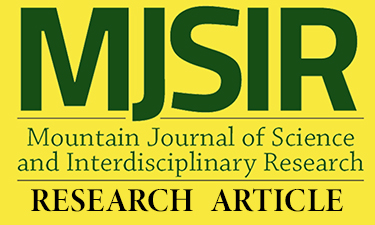Ethnomathematics on the Rice Cultivation Practices in Sablan, Benguet
Main Article Content
Abstract
This descriptive-interpretive design documented Ethnomathematics pertaining to rice cultivation practices in Sablan, Benguet. Interviews were conducted among the identified key informants of the indigenous people of Sablan, Benguet, identified through purposive sampling. Results showed that accounting for rice harvest involved simple counting while ciphering included posting purong in rice fields. Estimation in measuring their rice harvest was documented as a common practice. Sequential steps in cultivation include seedling preparation, land preparation, transplanting, pest control, harvesting, and drying. Harvests were categorized by variety and harvest time. Additionally, beliefs related to rice cultivation were also observed by the people of Sablan. They predict the weather based on the arrival of specific birds and the color of rice grains. Further, their planting method exhibited mathematical patterns and the sidewalls of their alang or rice granary displayed modeling patterns. Their rice cultivation practices showed the rich culture of the people which is worth documenting. Other indigenous practices may be documented to preserve the local practices. The identified ethnomathematics on rice cultivation practices may be incorporated into teaching math concepts. The community was also encouraged to participate in teaching the practices to the younger generations for cultural preservation and promotion.
Article Details
References
Banghart, S., & Putnam, L. (2017). Interpretive Approaches. https://doi.org/10.1002/9781118955567.wbieoc118
D'ambrosio, U. (2001). What is Ethnomathematics and How It Can Help Children in Schools? Teaching Children Mathematics. National Council of Teachers of Mathematics. https://math. hawaii.edu/~mchyba/documents/syllabus/Math499/Ethnomath/Ambrosio1.pdf
Elliott, R., & Timulak, L. (2021). Essentials of Descriptive-Interpretive Qualitative Research: A Generic Approach. American Psychological Association. https://doi.org/10.1037/0000224-000
Hossain, M., & Fischer, K.S. (1995). Rice Research for Food Security and Sustainable Agricultural Development in Asia: Achievements and Future Challenges. GeoJournal, 35(3): 286-298. http:// www.jstor.org/stable/4146409.
Lodias, D. (2018). The Ethnomathematics Practices in Bakun, Benguet. Unpublished Master's Thesis. Benguet State University, La Trinidad, Benguet.
Mania, S., & Alam, S. (2021). Teachers' Perception Toward the Use of Ethnomathematics Approach in Teaching Math. International Journal of Education in Mathematics, Science and Technology, 9(2): 282-298. https://doi.org/10.46328/ijemst. 1551.
Marleny A.S., Somakin, U., Aisyah, N., Dr., D., & Araiku, J. (2020). Ethnomathematics: Learning Using Oil Palm Cultivation Context. Journal of Physics: Conf. Ser. 1480 012011.
Narvaez, L. (2020). Indigenous Knowledge System (IKS) in Crop Farming in Albay Province, Philippines: An Analysis for Validation Studies. BU R&D Journal, 23(2): 78-86.
Philippines Statistics Authority. (2017). Consumption of Selected Agricultural Commodities in the Philippines -Volume II. https://psa.gov.ph/sites/defaultfiles/2015-2016%20CSAC%20Vol2.pdf.
Philippines Statistics Authority. (2020). PhilRice Magazine. https://www.philrice.gov.ph/wpcontent/uploads/2022/06/PhilRice-Newsletter2021-Jan-Feb.pdf
Portilla, J.C., & Mirandilla, J.R.F. (2013). Documentation of Indigenous Practices in Upland (traditional) Rice Production Areas and Site Characterization in CAR. Philippine Journal of Crop Science. https://agris.fao.org/agrissearch/ search.do?recordID=PH2014000627#:~:text=There%20are%20about%2025%20traditional,the%20common%20method%20of%20planting.
Rosa, M., D'ambrosio, U., Orey, D.C., Shirley, L., Alangui, W.V., Palhares, P., & Gavarrete, M.E. (2016). Current and Future Perspectives of Ethnomathematics as a Program. Springer. https://www.springer.com/series/14352
Rubio, J. (2016). The Ethnomathematics of the Kabihug Tribe in Jose Panganiban, Camarines Norte, Philippines. Malaysian Journal of Mathematical Sciences, 10(S): 211-231. http://upm.edu.my/journal/fullpaper/vol10saugust/16.%Jennifer.pdf,
Siambombe, A., Mutale, Q., & Muzingili, T. (2018). Indigenous Knowledge Systems: A Synthesis of Batonga People's Traditional Knowledge on Weather Dynamism. African Journal of Social Work, 8(2): 46-54.
Statista Research Department. (2022). Production Volume of Rice in the Philippines 2012-2021. https://www.statista.com/statistics/751778/Philippines-paddy-production/
Suayan, C. (2012). Documentation of the Indigenous Rice Farming Practices of Residents in Daklan, Bokod, Benguet. Unpublished Undergraduate Thesis. Benguet State University, La Trinidad, Benguet.
Talango, F. (2010). The Indigenous Practices of Rice Farmers in Barangay Poitan, Banaue, Ifugao. Unpublished Undergraduate Thesis. Benguet State University, La Trinidad, Benguet.
Tebtebba Foundation. (2020). Indigenous Knowledge Systems and Practices in The Philippines Status and Trends. https://www.tebtebba.org/index.php/resources-menu/publications-menu/resourcebook/141-indigenous-knowledge-systems-andpractices-in-the-philippines-status-and-trends
Tutak, F.A., Bondy, E., & Adams, T.L. (2010). Critical Pedagogy for Critical Mathematics Education. International Journal of Education in Mathematics, Science and Technology, 42(1). https://doi.org/10.1080/0020739X.2010.510221.

